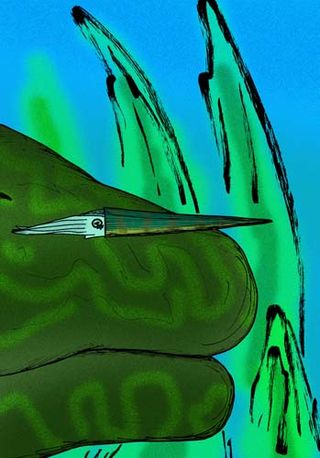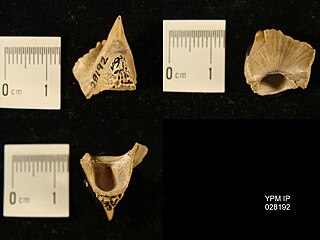Related Research Articles
Discosorida are an order of cephalopods that lived from the beginning of the Middle Ordovician, through the Silurian, and into the Devonian. Discosorids are unique in the structure and formation of the siphuncle, the tube that runs through and connects the camerae (chambers) in cephalopods, which unlike those in other orders is zoned longitudinally along the segments rather than laterally. Siphuncle structure indicated that the Discosorida evolved directly from the Plectronoceratida rather than through the more developed Ellesmerocerida, as did the other orders. Finally and most diagnostic, discosorids developed a reinforcing, grommet-like structure in the septal opening of the siphuncle known as the bullette, formed by a thickening of the connecting ring as it draped around the folded back septal neck.

Plectronocerida is a primitive order from which subsequent cephalopod orders are ultimately derived.
Ectenolites is a genus of small, slender, cylindrical Ellesmeroceratids that resemble Ellesmeroceras but are smaller and proportionally narrower. Septa, as typical for ellesmerocerids, are close spaced with shallow lobes on either flank. The body chamber is proportionally long, the shell itself slightly compressed. The dorsal side at the beginning of the shell, opposite the aperture and body chamber, is strongly convex so to produce a sense of endogastric curvature with the apex and siphuncle aligned.

Lamellorthoceratidae is a family of fossil orthoceratoids in the Orthocerida, defined by Curt Teichert in 1961. The lamellorthoceratids are placed in the superfamily Orthocerataceae in the Treatise on Invertebrate Paleontology.

Knightoconus antarcticus is an extinct species of fossil monoplacophoran from the Cambrian Minaret Formation of Antarctica. It is thought to represent an ancestor to the cephalopods. It had a chambered conical shell, but lacked a siphuncle.
The Reudemannoceratidae are the ancestral and most primitive of the Discosorida, an order of cephalopods from the early Paleozoic. The Reudemannoceratidae produced generally medium-sized endogastric and almost straight shells with the siphuncle slightly ventral from the center.
Ulrichoceras is recognised as the basal cyrtogomphoceratid genus, which is the source for the rest of the Cyrtogomphoceratidae as well as for the Westonoceratidae. The Cyrtogomphoceratidae are endogastric, the Westonoceratidae, exogastric.
Westonoceras is an extinct nautiloid genus from the Discosorida that lived during the Middle and Late Ordovician that has been found in North America, Greenland, and Northern Europe. It is the type genus for the Westonoceratidae

The Phragmoceratidae is a family of extinct nautiloid cephalopods from the Order Discosorida that lived during the latter part of the Silurian.
Protcycloceratidae is an extinct family of slender, commonly annulate, members of the cephalopod order Ellesmerocerida that lived during the Early Ordovician.

Belosaepia, occasionally incorrectly Belosepia, is an extinct genus of cuttlefish-like cephalopod known from the Eocene.
Nothoceratidae is a family of nautiloid cephalopods in the orthoceratoid order Oncocerida in which shells are exogastrically or endogastrically breviconic, planospiral, or torticonic; often with a constricted or visored aperture; and a siphuncle commonly composed of concave segments and occupied by actinosiphonate deposits. Some ten genera have been described which lived during the time between the Early Silurian and Late Devonian. The ancestral form is probably Perimecoceras which is known from the Upper Silurian of central Europe and which is similar in external form the Oonoceras from the Oncoceratidae.
Paraplectronoceras is a genus of very early nautiloids from the middle Late Cambrian, named by Chen and Qi, 1979, type species Paraplectronoceras pyriforme, for small, endogastrically curved forms found in the upper Yenchou and Wanwankou members of the Fengshan Formation of northeastern China.
Hectoceras is a genus in the nautiloid cephalopod order Discosorida from the Upper Ordovician of Australia (Tasmania), known from a few isolated siphuncle specimens.
Troostoceras is a genus of actinoceratid nautiloids with a cyrtoconic shell, otherwise similar to Actinoceras. The shell is slightly endogastric, curved such that the under or ventral side is longitudinally concave, tucked in. The siphuncle is ventral and is in contact with the shell wall. Segments begin small but expand during growth.
Cyrtogomphoceras is a genus of nautiloid cephalopods, recognized by its large breviconic shell with a notable endogastric curvature. The shell is fusiform in profile, reaching maximum width at or near the base of body chamber, which narrows toward the aperture. The siphuncle is large and slightly removed from the ventral side, that with the concave longitudinal profile. Siphuncle segments are short, as are chambers; septal necks recurved, connecting rings thick, bullettes at the apical end of the rings swollen. Cameral deposits are lacking.
Konglungenoceras is a discorid from the lower Silurian of Europe (Norway) and part of the Cyrtogomphocerae family. It lacks the septal foramina grasping bullettes at the adapical end of the connecting rings. Its shells are endogastric and strongly compressed, such that the ventral or siphuncle side is curved inward and the dorso-ventral height is greater than the width. Endosiphuncular deposits in the apical portion of the siphuncle consist of thick overlapping parietal laminae that form endocones, similar to those of Discosorus and Alpenoceras.
Discosoridae comprise a family of endogastric discosorids, with endocones in the siphuncle, ranging from the Middle Silurian to Middle Devonian.
Polyelasmoceratidae is a family of oncocerid nautiloids characterized by rapidly expanding endogastrically curved shells, curved such that the ventral side is longitudinally concave. In cross section shells are typically tear-drop in shape to subtriangular. The siphuncle is typically nummuloidal, like a string of beads, with outwardly flared septal necks, and located between the center and the venter. Most contain radially lamellar actinosiphonate deposits.
Codoceras is a genus of nautiloids belonging to the Polyelasmoceratidae, an Oncocerida family.
References
- Sweet, Walter C. 1964. Nautiloidea -Orthocerida. Treatise on Invertebrate Paleontology, Part K. Geological Soc. of America and Univ of Kansas press.